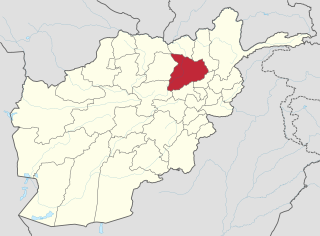
Baghlan is one of the thirty-four provinces of Afghanistan. It is in the north of the country. As of 2020, the province has a population of about 1,014,634.

Baghlan is a city in northern Afghanistan, in the eponymous province, Baghlan Province. It is located three miles east of the Kunduz River, 35 miles south of Khanabad, and about 500 metres above sea level in the northern Hindu Kush. Baghlan's capital, Pul-e-Khumri, is known to be an economic hub connected to eight other provinces by the Kabul-North highway.

Puli Khumrī, also spelled Pul-i-Khumri or Pol-e Khomri, is a city in northern Afghanistan. Puli Khumri is the capital and largest city of Baghlan Province, whose name comes from the other major town in the province, Baghlan. The city has an estimated population of about 221,274 as of 2015, making it about the 9th-largest city of Afghanistan, and the second-largest city in northeastern Afghanistan after Kunduz. It is a major industrial city.
Puli Hisar or Pul-e-Hesar is a district in Baghlan province, Afghanistan.
Farang wa Gharu or Firing wa Gharu is a district in Baghlan province, Afghanistan. It was created in 2005 from part of Khost wa Fereng District.
Guzargahi Nur or Gozargah-e-Noor is a district in Baghlan province, Afghanistan. It was created in 2005 from part of Khost wa Firing District.

Khwaja Hijran is a district in the Baghlan Province of Afghanistan. The district was created in 2005 from part of Andarab District. The name of the district has already been changed and its new one is Jalga. It has a population of about 23,000, and its main village is Pansíri.
Andarab is district located in the southern part of Baghlan Province, Afghanistan. The estimated population of Andarab in 2004 was roughly 120,642. The district centre is the village of Andarab, which is named after the Andarab valley in which it is located.

Baghlani Jadid, is a district of Baghlan Province in northern Afghanistan. It has a population of about 119,607.

Dahana i Ghuri district is located in the most southwestern part of Baghlan province, Afghanistan. The capital is Dahana i Ghuri. Its population is about 3,400 people. It is connected with Baghlan and Puli Khumri with an all-weather primary road.

Dushi district is located in the central part of Baghlan Province, Afghanistan. It lies on the major Kabul-Kunduz highway. The population of the district was estimated to be around 57,160 in 2004. Hazaras are around 60% of the population and make up the majority in the district, followed by Tajiks (39%). The centre of the district is Dushi. Dushi was considered contested between the Afghan Government and the Taliban in late 2018.

Khinjan District is located in the southern part of Baghlan province in the Hindu Kush mountains. The capital is the town of Khenjan. The main Kabul-Kunduz highway passes through the district from south to west. Ethnic Tajiks makes up around 85% of the total population while the Pashtuns, Hazara and Uzbeks, each at 5%, makes up the remaining 15% of the population.
Tala wa Barfak is a district situated in the most southwestern part of Baghlan province, Afghanistan, and its capital is Tala wa Barfak village.
Baghlan was a district in Baghlan Province, Afghanistan. The main town of the district was also known as Baghlan. In 2005, Baghlan was annexed into the district of Baghlani Jadid, also in Baghlan Province.
Aodan is the name of three reservoirs in Afghanistan on the road from Khulm (Tashkurgan) to Kunduz, and another one on the road from Kunduz to Hazrat Imam. Taken as a whole, these reservoirs had been the only water available between Kunduz and the Hazrat Imam.
Qataghan Province, was a province of Afghanistan which became defunct in 1963, when it was divided into the current Baghlan Province, Kunduz Province, and Takhar Province.
Sayed Mansur Naderi is a leader of an Ismaili Shi'a community centred in Baghlan Province of Afghanistan. Like other Ismaili communities in Afghanistan and worldwide, the Baghlan Ismailis do submit to the spiritual leader of Ismailis worldwide, the Agha Khan, Naderi acts as a figurehead of the local Ismailies till the socio/religious leadership structure is established in the country. This community although Shia is smaller than the mainstream Twelver Shia community in Afghanistan.
Baghlan University was established in 1993 as Hakim Naser Khesraw University, and later burned down in 1998 by the Taliban. Following the fall of the Taliban the university resumed operation in 2003. As of 2007, construction is ongoing on a permanent university complex in Hussain Khel. Baghlan University is one of the leaders in Afghanistan, one of the 5 best universities in the country.
On 15 August 2018, Taliban fighters attacked an Afghan National Army base and police checkpoints in Baghlan Province, the fighting lasted five hours and resulted in the deaths of at least 36 soldiers and 9 policemen. The attack occurred the same day Kabul was struck by a suicide bombing that left 48 dead, and one day after a base was besieged in Faryab. Hundreds of Taliban fighters reportedly took part in the predawn attack according to anonymous Afghan police official, by the end, the base had been completely overrun. Only two soldiers survived the attack, causing Afghan officials to believe they were possibly involved







